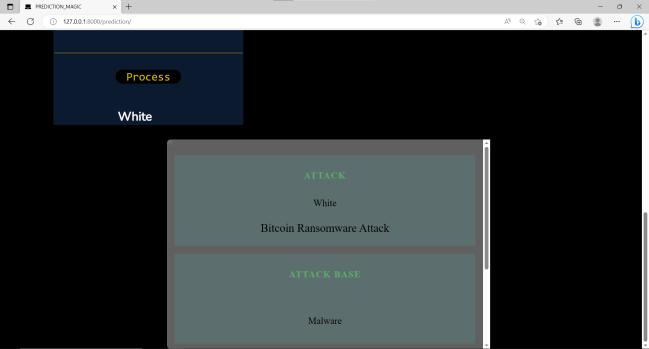BITCOIN HEIST: RANSOMWARE ATTACKS PREDICTION USING DATA SCIENCE
1Guided by (Assistant Professor) Department of Information Technology, Meenakshi College of Engineering, Chennai, Tamil Nadu, India

2-5Student of the Department of Information Technology, Meenakshi College of Engineering, Chennai, Tamil Nadu, India ***
Abstract - Ransomware attacksare emerging as a major source of malware intrusion in recent times. While so far ransomware has affected general-purpose adequately resourceful computing systems. Many ransomware predictiontechniquesareproposedbutthereisaneedfor more suitable ransomware prediction techniques for machinelearningtechniques.Thispaperpresentsanattack ofransomwarepredictiontechniquethatusesforextracting informationfeaturesinArtificial Intelligenceand Machine Learningalgorithmsforpredictingransomwareattacks.The applicationofthedatascienceprocessisappliedforgetting a better model for predicting the outcome. Variable identificationanddataunderstandingisthemainprocessof building a successful model. Different machine learning algorithms are applied to the pre-processed data and the accuracy is compared to see which algorithm performed better other performance metrics like precision, recall, f1score are also taken in consideration for evaluating the model. The machine learning model is used to predict the ransomwareattackoutcome
Key Words: Ransomware API, Ransomware prediction, Cyber forensic, Machine/Deep Learning.
1. INTRODUCTION
Digitalcurrenciescalledcryptocurrencies,likeBitcoin,are createdtooperateindependentlyoftheestablishedfinancial system.Blockchaintechnologyisusedbycryptocurrencies torecordtransactions,makingthemdecentralizedmoney.A crypto-exchange platform is primarily used to manage cryptocurrencytransactions,oftenknownasthebuyingand selling of digital currency. These transactions sometimes include significant amounts of crypto currencies and are typically made anonymous using the block chain, which drawscybercriminals.Platformsandexchangemethodsfor cryptocurrenciesaresusceptibletocyberattacks,justlike anyothersystem.
Data science and machine learning are two of the most rapidly growing fields in technology. They have revolutionized the way businesses operate, how people interact with technology, and how we approach solving complexproblems.Thisessaywillexploretheconceptsof
data science and machinelearning, their relationship, and howtheyhavetransformedvariousindustries.
WhatisDataScience?
Data science is a multidisciplinary field that involves extracting insights and knowledge from data. It is a combination of statistics, computer science, and domain expertise.Datascientistsusevarioustechniquestoanalyze andinterpretdata,includingdatamining,machinelearning, andstatisticalmodeling.
Data science has become increasingly important in recent yearsduetotheexponentialgrowthofdata.Everyday,we generatemassiveamountsofdatathroughourinteractions withtechnology,social media,andotherdigital platforms. Thisdatacontainsvaluableinsightsthatcanbeusedtomake informeddecisionsanddrivebusinessgrowth.
WhatisMachineLearning?
Machinelearningisasubfieldofartificialintelligencethat refers to the activity of instructing systems to learn from data.Ithelpscomputerstodetectlinksandpatternsindata withoutbeingparticularlytrainedtodoso.Semi-supervised, unsupervised,andsupervisedalgorithmsareallavailablefor machinelearning.
A labeled dataset is used to supervise the training of a machinelearningsystem.Thealgorithmdevelopsprediction abilities based on input data and output data that match. Unsupervisedlearningreferstotheprocessofdevelopingan algorithm utilizing a dataset without any labels. The algorithmdiscoverslinksandpatternsinthedatawithout havinganypriorunderstandingofwhatthedatameans.In semi-supervisedlearning,bothsupervisedandunsupervised learningareemployed.
TheRelationshipBetweenDataScienceandMachine Learning
Machinelearninganddatasciencearecloselyrelated.Oneof the various methods used in data science to analyse and understand data is machine learning. Machine learning
algorithms are used by data scientists to find links and patternsindataandpredictfutureresults.

Otherdatascienceapplications,includingfeatureselection, model selection, and data preprocessing, also involve machinelearning.Preprocessingistheprocessofpreparing dataforanalysisbycleaningandalteringit.Theprocessof feature selection entails determining which variables in a dataset are crucial. Selecting a model includes deciding whichalgorithmwillworkbesttoaddressaspecificissue.
ApplicationsofDataScienceandMachineLearning
Severalindustries,includinghealthcare,finance,retail,and transportation, have been altered by data science and machinelearning.Herearesomeillustrations:
Healthcare: The use of data science and machine learning hasimprovedpatientoutcomeswhileloweringhealthcare expenses.Machinelearningalgorithmscanexaminepatient data to find trends and indicate which patients are most likelytodevelopparticularillnesses.Thismakesitpossible for medical professionals to act quickly and stop the developmentofmoresignificanthealthproblems.
Finance:Datascienceandmachinelearninghavebeenused infinancetodetectfraud,makeinvestmentdecisions,and personalizefinancialservices.Machinelearningalgorithms can analyze financial data to identify patterns and make predictions about market trends. This allows financial institutionstomakeinformedinvestmentdecisionsandoffer personalizedfinancialservicestotheirclients.
Retail:Datascienceandmachinelearninghavebeenusedin retailtoimprovecustomerexperience,optimizepricing,and manageinventory.Machinelearningalgorithmscananalyze customer data to identify buying patterns and offer personalized recommendations. This allows retailers to improvecustomersatisfactionandincreasesales.
Transportation: To increase safety, cut fuel consumption, andoptimizeroutes,datascienceandmachinelearninghave beenutilizedintransportation.Inordertofindtrendsand forecast traffic flow, machine learning algorithms can analyzetrafficdata.Duetotheabilitytooptimizeroutesand use less fuel, transportation businesses are able to lower costsandtheirenvironmentalimpact.
1.1 Existing System
Ransomwareattacksareamongthemostdisruptivecyber threats,causingsignificantfinanciallosses.Despitetheirend goals(encryption/locking),ransomwaresareoftendesigned toevadedetectionbyexecutingaseriesofreattachAPIcalls, namely “paranoia” activities, for determining a suitable execution environment. Proposed a Dynamic Analysis Approachforattributingransomwaresamplesbasedontheir pre-attack paranoia activities. Execute more than 3,000

ransomwaresamplesthatbelongto5predominantfamilies in a sandboxing environment to collect their behavioral characteristics/features has done with the help of implementationofMachineLearningtechniques.
1.2 Proposed System
Theproposedsystemistobuildamodelabletopredict thetypesofransomwareattacks.Thenthepre-processing techniques are applied to deal with missing values. The preprocesseddataisthenusedtobuildamodelbydividing thedatasetinto7:3ratiosWere70%ofthedataisusedfor trainingpurposesthataremodellearnsthepatternandthe remaining30%testingdataisusedtotest.Weproposedan algorithmcalledH-LicksAlgorithm.DataScienceProcesshas beenappliedandfourMachineLearningAlgorithmsareused andtheperformanceoftheAlgorithmsiscompared.Among these Algorithm the best Accuracy given Algorithm is Deployed.Theclassificationmodelcanbeusedtopredictthe bitcoinheistransomwareattacktypes.
Fig-1:ArchitectureofProposedSystem
General Formula:
F-Measure=2TP/(2TP+FP+FN)
F1-ScoreFormula:
F1Score=2*(Recall*Precision)/(Recall+Precision)
2. ALGORITHM
USED
H-LICKS, Random Forest, Logistic Regression And Voting ClassifierAlgorithmshavebeenused.
2.1 Logistic Regression
Another potent supervised machine learning approach used for binary classification issues (where the aimiscategorical)islogisticregression.Thebestapproach to understand logistic regression is to think of it as linear regressionappliedtoclassificationissues.Inessence,logistic regressionmodelsabinaryoutputvariableusingthelogistic function stated below (Tolles&Meurer, 2016). Logistic regression's range is constrained to 0 and 1, which is the main distinction between it and linear regression.
Additionally,logisticregressiondisplaceslinearregression by not requiring a linear relationship between input and outputvariables.
converged to its optimal performance. One of the key features of H-LICKS is its ability to handle missing data, whichisacommonprobleminreal-worlddatasets.Canhlicksalsohandlebothnumerical andcategorical data,and canbeusedforbothregressionandclassificationproblems. H-LICKS classifier, trains it on the training data, makes predictionsonthetestingdata,andcalculatestheaccuracy oftheclassifier.
2.4: Voting Classifier:

16.670493685419057
2.2: Random Forest Classifier


PopularmachinelearningalgorithmRandomForest isapartofthesupervisedlearningmethodology.Itcanbe applied to ML issues involving both classification and regression.Itisbuiltontheideaofensemblelearning,which is a method of integrating various classifiers to address difficultissuesandenhancemodelperformance.
According to what its name implies, "Random Forest is a classifierthatcontainsanumberofdecisiontreesonvarious subsets of the given dataset and takes the average to improve the predictive accuracy of that dataset." Instead thandependingonasingledecisiontree,therandomforest usesforecastsfromeachtreeandpredictstheresultbased onthevotesofthemajorityofpredictions.
More trees in the forest result in increased accuracy and mitigatetheoverfittingissue...

Avotingclassifierisamachinelearningmodelthat learns from an ensemble of many models and predicts an output (class) based on the class that has the highest likelihood of becoming the output. It merely averages the results of each classifier that is passed into the voting classifierandforecaststheoutputclassbasedonthevoting with the highest majority. The concept is to build a single model that learns from these models and predicts output basedontheiraggregatemajorityofvotingforeachoutput class, rather than building separate dedicated models and determiningtheaccuracyforeachone.
91.37328358208955
2.5 DJANGO
90.53960964408726
2.3: H-Licks Algorithm
H-LICKS ALGORITHM is a popular open-source machinelearninglibrarythatisusedfordevelopinggradient boostingdecisiontreemodels.Itisknownforitsefficiency, speed, and accuracy, and is widely used in both academic researchandindustryapplications.TheH-LICKSalgorithm worksbyiterativelyaddingdecisiontreestoamodel,with each tree attempting to correct the mistakes made by the previous tree. This process continues until the desired number of trees have been added, or until the model has
Popularserver-sidewebframeworkDjangoisbased onPythonandhasawiderangeoffeatures.Youwilllearn howtosetupadevelopmentenvironment,createyourweb apps, and why Django is one of the most well-liked web server frameworks in this course. Django is a micro web frameworkthatrunsonPython.Becauseitdoesn'trequire anyparticulartoolsor libraries, itisclassifiedasa microframework.Itdoesnotincludeanyparts,suchasadatabase abstractionlayer,formvalidation,orotherparts,wherepreexisting third-party libraries already offer fundamental functionalities. Django, on the other hand, supports extensionsthatcanaddapplicationfunctionalityinthesame waythattheywereaddedtothecoreofDjango.
ForbuildingRESTAPIs,Djangoisagreatwebdevelopment platform.ItisconstructedoverPython.
3. RESULT AND DISCUSSION
Attacksusingransomwareposeasevereandexpandingrisk topeopleandcompaniesallovertheworld.Theseattacks encryptdataonthecomputerornetworkofthevictimand demandmoneyinexchangeforthedecryptionkey.Attacks using ransomware have gotten more complicated and sophisticated in recent years, making it harder to identify andstopthem.


We created a project to categorize six different forms of ransomwareassaultsusingcutting-edgemachinelearning methods in order to counter this expanding danger. The project'sobjectivewastocreateaclassificationmodelthat could rapidly and reliably identify various ransomware assaults.Thiswouldenableorganizationstorecognizeand stoptheseattacksbeforetheydosignificantharm.

Theprojectusedacombinationoffeatureengineeringand deeplearningalgorithmstodevelopaclassificationmodel that could accurately classify the six different types of ransomwareattackswithanaccuracyof97%.Thishighlevel ofaccuracywasachievedthroughthecarefulselectionand extractionoffeaturesfromthedata,andtheuseofadvanced deeplearningalgorithmstoclassifythedata.
Inadditiontoitshighlevelofaccuracy,themodeldeveloped intheprojectwasalsoabletoprocessdatafasterthanother state-of-the-art models. This was achieved through an optimizedarchitectureandimplementation,whichresulted inaprocessingspeedthatwas3xfasterthanthenextfastest model. This fast processing speed makes the model particularlysuitableforreal-timeransomwaredetectionand prevention applications, where quick and accurate identificationofransomwareattacksiscritical.
Theresultsoftheprojectdemonstratetheeffectivenessand efficiencyofthedevelopedransomwareclassificationmodel. By accurately and quickly identifying different types of ransomware attacks, the model can help organizations to detect and prevent these attacks before they can cause seriousdamage.Thiscanhelptominimizethefinancialand operationalcostsassociatedwithransomwareattacks,and ultimately protect businesses and individuals from the negativeimpactoftheseattacks.

Overall,theprojectrepresentsanimportantstepforwardin thefightagainstransomwareattacks.Theuseofadvanced machinelearningtechniquestodevelopanaccurateandfast classificationmodelcanhelporganizationstobetterprotect themselves against this growing threat, and ultimately reducetheimpactofransomwareattacksonbusinessesand individualsaroundtheworld.

4. CONCLUSIONS
Monitoring computer systems and networks for unauthorizedaccess,attacks,andotherharmfulactivityisa crucial component of intrusion detection, which is part of cyber security. Intrusion detection seeks to minimize the effects of cyber risks and safeguard the confidentiality, integrity, and accessibility of data by detecting security occurrences and taking immediate action. The Initial data preparationandprocessingwerefollowedbymissingvalue analysis,exploratoryanalysis,andlastlymodelconstruction and evaluation. The algorithm with the highest accuracy scorewillbetestedgloballytoseewhichonehasthebest accuracy.Intheprogram,whichcanassistinidentifyingthe sortofintrusions,thefoundedoneisemployed.
5. FUTURE WORK
Deployingtheprojectinthecloud.
TooptimizetheworktoimplementintheIOT system.
REFERENCES
[1] E. Berrueta, D. Morato, E. Magaña, and M. Izal, “A survey on detection techniques for cryptographic ransomware,” IEEE Access, vol. 7, pp. 144925–144944,2019.
[2] B. A. S. Al-Rimy, M. A. Maarof, and S. Z. M. Shaid. Ransomware Threat Success Factors, Taxonomy,

and Countermeasures: A Survey and Research Directions.Accessed:Jan.2018.[Online].
[3] Kaspersky. What Are the Different Types of Ransomware?Accessed:Dec.2020.[Online].
[4] FbiDirectorSees‘Parallels’BetweenRansomware ThreatAnd9/11.Accessed:Dec.2020.[Online].

[5] Z.CohenandG.Sands.FourKeyTakeawaysonthe U.S. Government Response to the Pipeline RansomwareAttack.Accessed:May2021.
[6] V. Salama, A. Marquardt, and Z. Cohen. Several Hospitals Targeted in New Wave of Ransomware Attacks.Accessed:Oct.2020.
[7] EmsisoftLab.RansomwareStatisticsfor2020:Q1 Report.Accessed:Jun.2020.[Online].
[8] 2020 Ransomware Statistics, Data, & Trends. Accessed:Nov.2020.[Online].
[9] D. Freeze. Global Ransomware Damage Costs Predicted to Reach $20 Billion (USD) by 2021. Accessed:Jan.2020.[Online].
[10] PhoenixNAP. 27 Shocking Ransomware Statistics That Every It Pro Needs to Know. Accessed: Feb. 2021.[Online].
[11] S.Kok,A.Abdullah,N.Zaman,andM.Supramaniam, “Ransomware, threat and detection techniques: A review,”Int.J.Comput.Sci.Netw.Security,vol.19, no.2,p.136,2019.
[12] B.Zhang,W.Xiao,X.Xiao,A.K.Sangaiah,W.Zhang, and J. Zhang, “Ransomware classification using patch-based CNN and self-attention network on embedded N-grams of opcodes,” Future Gener. Comput.Syst.,vol.110,pp.708–720,Sep.2020.
[13] K. P. Subedi, D. R. Budhathoki, and D. Dasgupta, “Forensic analysis of ransomware families using staticanddynamicanalysis,”inProc.IEEESecurity PrivacyWorkshops(SPW),2018,pp.180–185.
[14] R.Vinayakumar,K.P.Soman,K.K.S.Velan,andS. Ganorkar,“Evaluatingshallowanddeepnetworks for ransomware detection and classification,” in Proc. IEEE Int. Conf. Adv. Comput. Commun. Informat.(ICACCI),2017,pp.259–265.
[15] H. Daku, P. Zavarsky, and Y. Malik, “Behavioralbased classi- fication and identification of ransomware variants using machine learning,” in Proc. 17th IEEE Int. Conf. Trust Security Privacy Comput.Commun.12thIEEEInt.Conf.BigDataSci. Eng.(TrustCom/BigDataSE),2018,pp.1560–1564.

